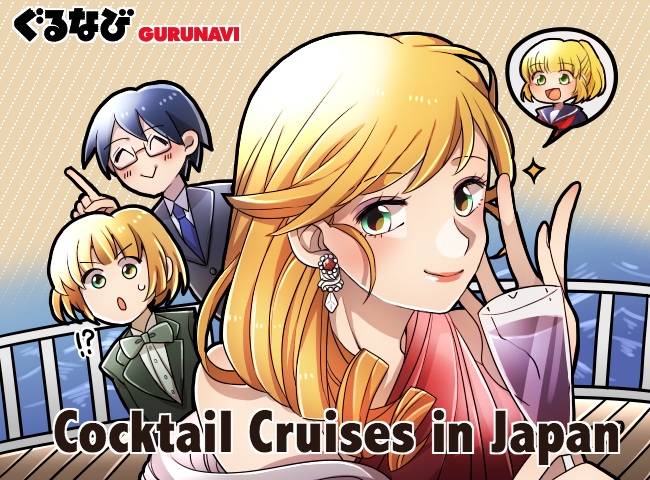Summary of Yakatabune and Japanese Cruising
Getting on a boat and cruising on a river or sea offers some excellent views you wouldn't normally get to enjoy.
 Plans where you can drink and eat while cruising are especially popular. In addition to lunch cruises, there are also dinner cruises where you can enjoy the evening and nighttime sights.
Plans where you can drink and eat while cruising are especially popular. In addition to lunch cruises, there are also dinner cruises where you can enjoy the evening and nighttime sights.
The "yakatabune" is a traditional cruising boat that has been used continuously since the Edo period. Yakatabune have a roof and a style distinctive of old Japan. They are a wonderful way to go sightseeing by river or sea. Yakatabune are normally rented out for parties, but "noriai" is sometimes available where you can ride with other passengers. Places that manage yakatabune are called "funayado." Funayado offer many different sightseeing courses and dining plans. Courses normally last 2 to 3 hours.
History of Yakatabune
Sightseeing cruises have a long history in Japan. In the 7th and 8th centuries, Japanese nobility would ride on decorated boats and read poems and perform music while enjoying the scenery. During the Edo period, rich samurai and merchants would compete in making lavish yakatabune, and would use them for sightseeing and dining. These lavish lifestyles were then outlawed, and extravagant yakatabune disappeared. After this, very basic yakatabune were constructed and commoners were able to enjoy cruising. Contemporary yakatabune developed during this time.
Enjoying Yakatabune
Enjoy the Seasons
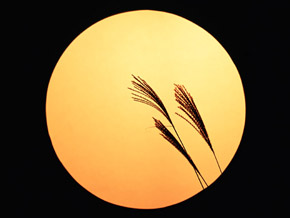 Spring, with the blossoming cherry trees; summer, with fireworks displays; autumn, with beautiful views of the moon; and winter, with beautiful white snow - all of the seasons can be enjoyed while riding on a yakatabune. Yakatabune are especially popular on days when there are fireworks displays scheduled.
Spring, with the blossoming cherry trees; summer, with fireworks displays; autumn, with beautiful views of the moon; and winter, with beautiful white snow - all of the seasons can be enjoyed while riding on a yakatabune. Yakatabune are especially popular on days when there are fireworks displays scheduled.
Afternoon and Evening Scenery
 Most yakatabune set out in the evening, but some yakatabune are available in the afternoon. Afternoon cruising offers different scenic views than those at night.
Most yakatabune set out in the evening, but some yakatabune are available in the afternoon. Afternoon cruising offers different scenic views than those at night.
Afternoon and Evening Scenery
Most yakatabune set out in the evening, but some yakatabune are available in the afternoon. Afternoon cruising offers different scenic views than those at night.
Yakatabune Amenities
It depends on the boat, but many yakatabune have air conditioning and a bathroom. Straw tatami mats are laid out on the floor of the boat. Some boats offer you zabuton cushions to sit on, while others have "horigotatsu," which are holes in the floor where you put your legs so you can sit up like sitting on a chair.
Riding a Yakatabune
Reservations are necessary for both full-boat rentals and noriai. You can either contact the funayado directly, or you can talk with a travel agent. If you are staying at a hotel, you can also ask the hotel to make reservations for you. You can search for funayado on Gourmet Navigator.
Kinds of Food Available on Yakatabune
Here are some dishes commonly served on yakatabune. Most serve Japanese course meals, but some funayado serve Western-style meals or regional dishes. The plan you choose determines the food you get. For more casual plans, you may get a "bento," a box into which your meal has been packed.
 |
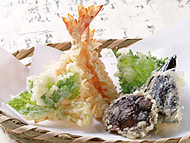 |
Edamame: Immature soybeans boiled in their pods. Push the beans out of their pods and eat. |
Tempura: Seafood, such as shrimp, conger eel, squid, etc., and vegetables dipped in batter and fried. Eaten with "tsuyu," a soy sauce-based soup, and salt. |
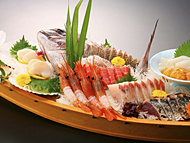 |
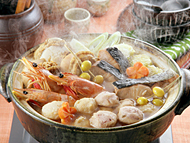 |
| Sashimi: Sliced raw fish. Eaten with soy sauce. Can be eaten with grated wasabi. Called "funamori" when served on a boat-shaped platter. | Nabe: Nabe (hot pot) is both a means of preparing food and the container that you eat out of. Because you continuously heat the nabe as you eat, this is a warm dish. |


